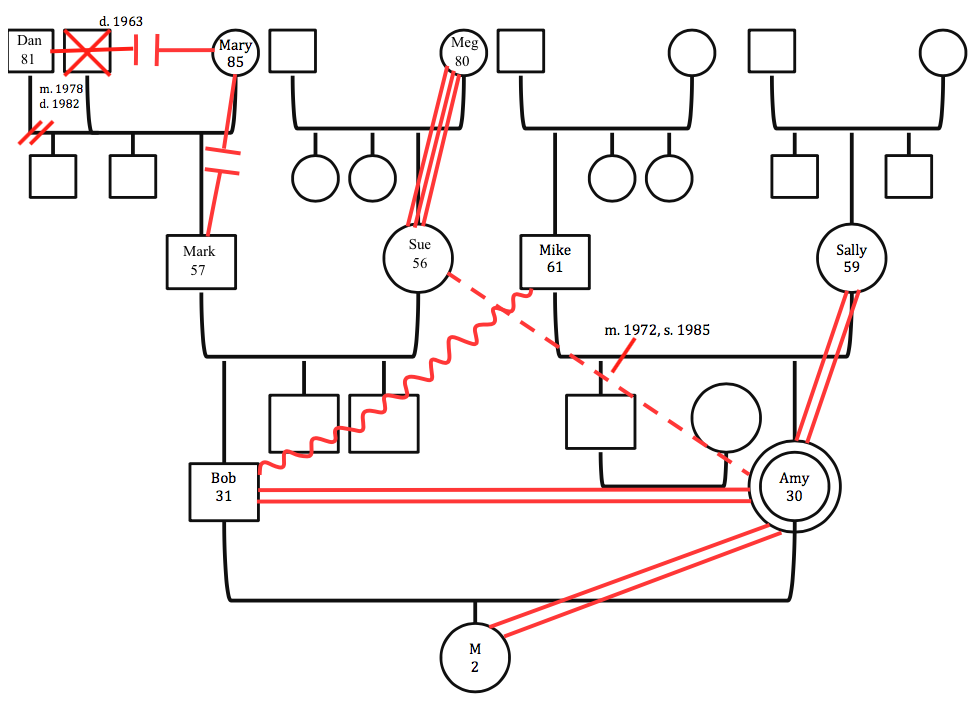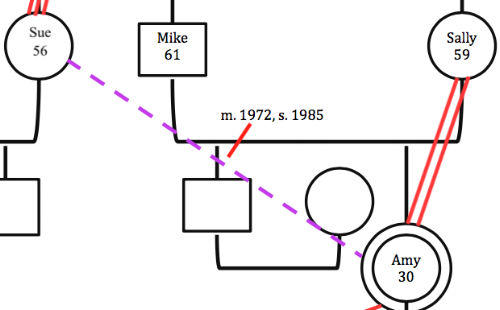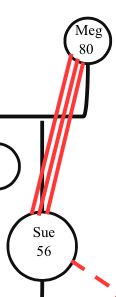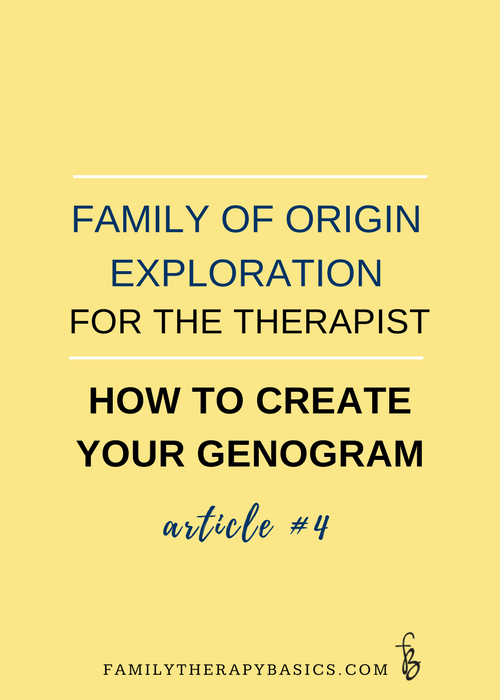This is the 6th article in the Family of Origin Exploration for the Therapist series. For additional articles, see the blog sidebar gallery, or "Related Posts" at the bottom of this post.
Relational dynamics are also referred to as relationship patterns or relationship lines; they are the symbols used on a genogram that connect family members to one another as well as illustrate details about their relationship.
In today's post, I will provide symbols for the five fundamental relational dynamics (closeness, distance, cut-off, fusion/enmeshment, and conflict), and show you how to add them to your genogram. If you haven't already completed your basic genogram (step 1), see this post. If you have completed step one, then please continue; you're ready to add relational dynamics to your genogram.
In the first genogram post, I began demonstrating the genogram process with Amy's fictitious family, and I've continued with this same genogram. Below is Amy's fictitious family genogram with relational dynamics noted.
Amy's four generation genogram
In the genogram above, the following relational dynamics have been added: Closeness between Amy and M, Bob, and Sally; distance between Amy and Sue; conflict between Bob and Mike; fusion between Sue and Meg; and cut-off between Mary and Dan, as well as Mary and Mark. I will now present each relational dynamic separately, so that you can understand each concept in order to add it to your genogram.
1 | Closeness
The symbol for closeness is two parallel solid lines. These lines are placed between the two individuals in the close relationship, as shown in Figure 1. The lines indicate that Amy characterizes her relationship with her husband, Bob, as well as her relationship with her daughter "M," as "close." A close relationship is marked by support, love, and a sense of safety (Marlin, 1989).
As you note relational dynamics on your genogram, remember that at this stage, your genogram is meant to record your view of each relationship. Do not be concerned with whether someone else would characterize the relationship differently. Also, mark the relationship based on your experience of it now, rather than at any point in the past.
2 | Distance
Figure 1: Closeness
Figure 2: Distance
The symbol for distance is a dashed or dotted line between the two individuals in the distant relationship, as noted with the purple line in Figure 2, placed between Sue and Amy. Again, because Amy is the family of origin "explorer," this means that she characterizes her relationship with Sue, her mother-in-law, as distant. A distant relationship is marked by indifference or avoidance (Marlin 1989).
3 | Cut-off
Figure 3: Cut-off
Cut-off is noted on a genogram with two "T" lines placed between the members of a cut-off relationship. Cut-off is marked in Figure 3 with purple "T" lines between Mary and Dan, as well as Mary and Mark. Cut-off is characterized by a lack of communication, usually due to ongoing conflict, or a conflictual event (Marlin, 1989).
According to Bowen (1985), both cut-off and fusion (another term for enmeshment) are responses to the anxiety generated within the family system. In fact, Bowen explains cut-off as a response to fusion; it occurs when the extreme closeness of fusion has become unbearable.
In Bob's family system, his paternal grandmother, Mary, is cut-off from her ex-husband (Dan) as well as her son, Mark (Bob's father). Mary is the "common denominator" in these relationships, which suggests that she initiated the cut-off. This would be a tentative hypothesis based solely on genogram information. Geograms are useful for giving the family of origin "explorer" a great deal of information, but of course, any hypotheses developed via genogram information must be tested in conversation with family members.
4 | Fusion/Enmeshment
The symbol for fusion is three parallel solid lines placed between the individuals in the fused relationship, as shown in Figure 4. These lines indicate that Sue has a fused relationship with her mother, Meg. Fusion is characterized by extreme closeness that limits the individuality of the persons in the relationship (Marlin, 1989).
Because Amy is not a member of this relationship, she is characterizing the relationship either by firsthand observation, or information she's received from Sue, Meg, or her husband, Bob. Similarly, as you prepare to add relational dynamics to others' relationships, or the generations "above" you on your genogram, use the knowledge you have from a variety of sources to choose relationship lines.
5 | Conflict
Figure 4: Fusion
Conflict is noted on a genogram with a wavy, or "up and down" line, placed between the two members of the conflictual relationship. The conflictual relationship between Bob and his father-in-law, Mike, is marked with a purple line in Figure 5.
A conflictual relationship is characterized by verbal (i.e. arguing) or nonverbal (e.g. passive aggression, silence, etc.) conflict as well as a general sense of discomfort.
Figure 5: Conflict
How to Add Relational Dynamics to Your Genogram
Take a look at the basic genogram you completed in step one. Begin noting relational dynamics in your current immediate family. This family is your chosen family (partner and/or children), or your family of origin (siblings and parents). If you have information about additional relationships in the generations "above" you on your genogram, add relational dynamics to those relationships as well. Include relational lines for as many relationships as possible.
Your genogram will most likely have more relational symbols than Amy's genogram, because I've only added details to a few relationships on Amy's genogram, in order to illustrate the five basic relational dynamics.
After adding relational dynamics, your genogram should have:
- The name and current age, or date of birth, of each person, inside their symbol
- Any deceased persons marked with an X through their symbol
- Divorces marked with two slanted lines perpendicular to the marital line
- Marital separations marked as one slanted line perpendicular to the marital line
- Relational dynamics, including closeness, distance, fusion, conflict, and cut-off, for as many relationships as possible
Summary
Relational dynamics are noted on your genogram with a variety of relationship lines that illustrate the type of relationship two parties have currently. These relationship characteristics give you, the family of origin explorer, a quick way of seeing relational habits in your family, as well as any relational generational patterns.
View the Video Summary
Let's Chat
- Do you have any questions about completing this step? If so, comment below, or ask them in the Get Refreshed Facebook group.
I've added the genogram template from this post (Amy's fictional family) to the free Family Therapy Basics resource library. If you're not already registered for the library, gain instant access by registering here:













